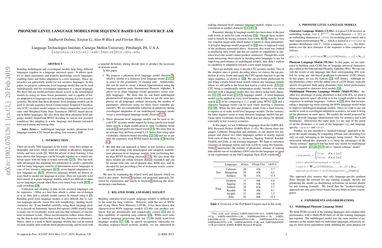Phoneme Level Language Models for Sequence Based Low Resource ASR
Building multilingual and crosslingual models help bring different languages together in a language universal space. It allows models to share parameters and transfer knowledge across languages, enabling faster and better adaptation to a new language. These approaches are particularly useful for low resource languages. In this paper, we propose a phoneme-level language model that can be used multilingually and for crosslingual adaptation to a target language. We show that our model performs almost as well as the monolingual models by using six times fewer parameters, and is capable of better adaptation to languages not seen during training in a low resource scenario. We show that these phoneme-level language models can be used to decode sequence based Connectionist Temporal Classification (CTC) acoustic model outputs to obtain comparable word error rates with Weighted Finite State Transducer (WFST) based decoding in Babel languages. We also show that these phoneme-level language models outperform WFST decoding in various low-resource conditions like adapting to a new language and domain mismatch between training and testing data.
PDF Abstract
